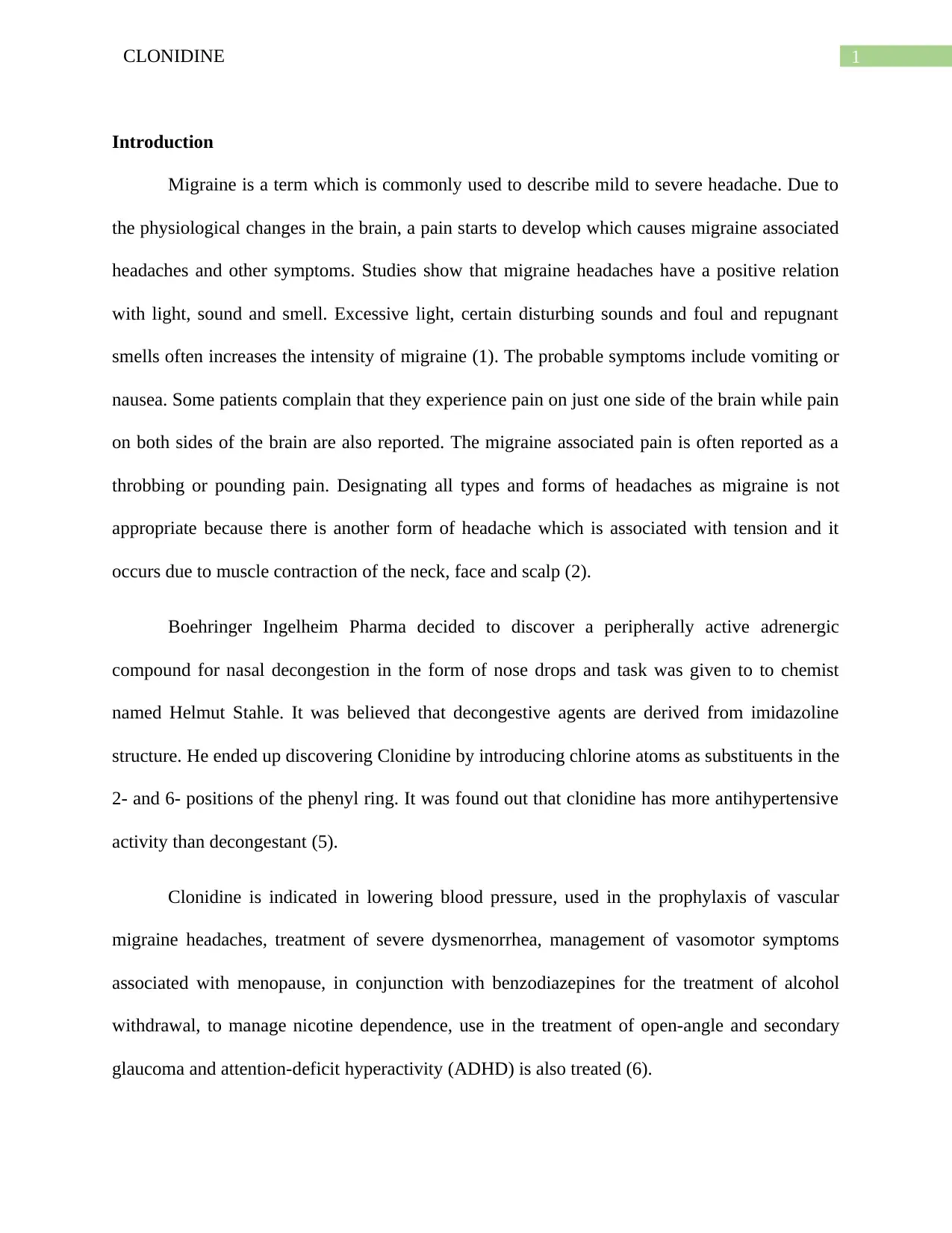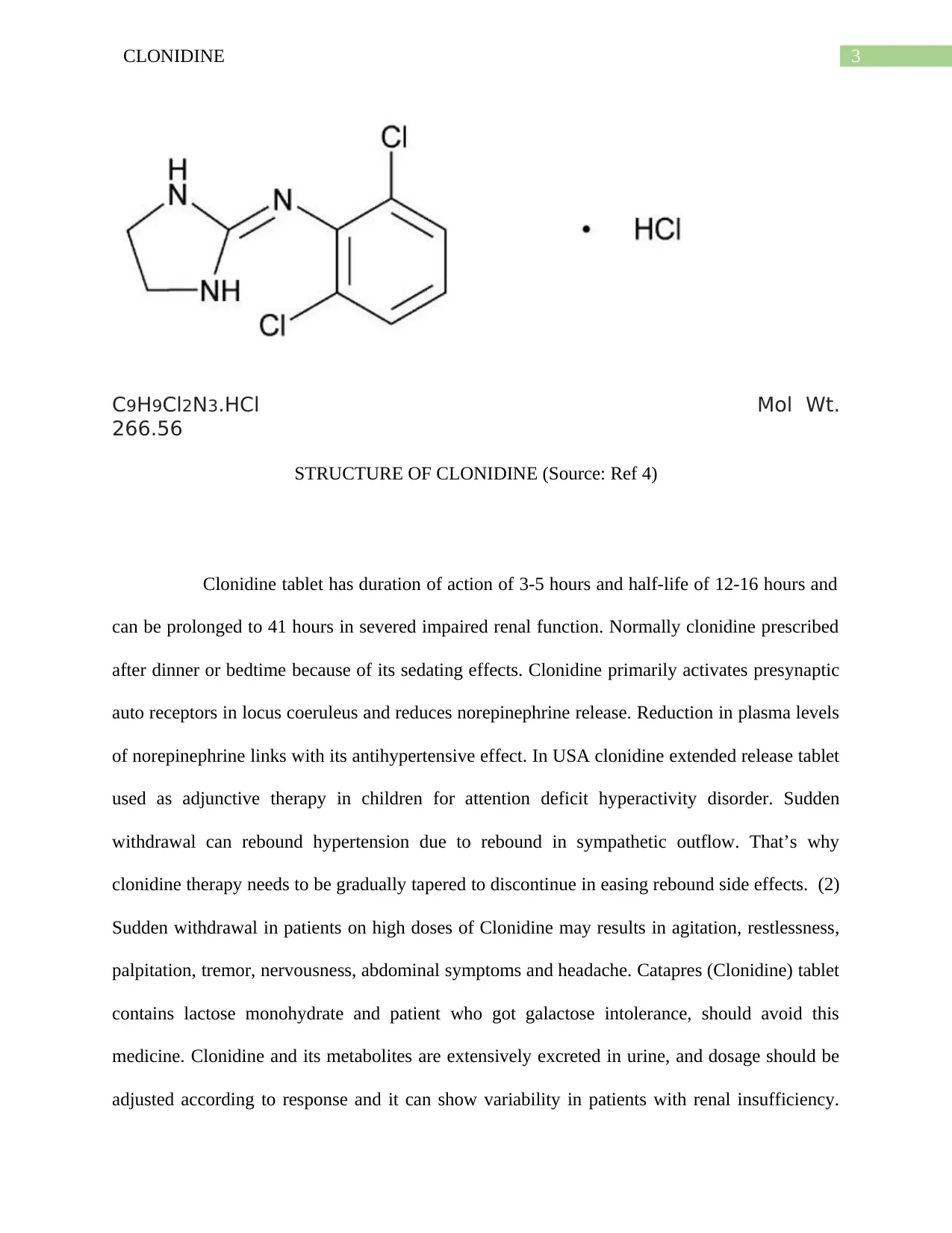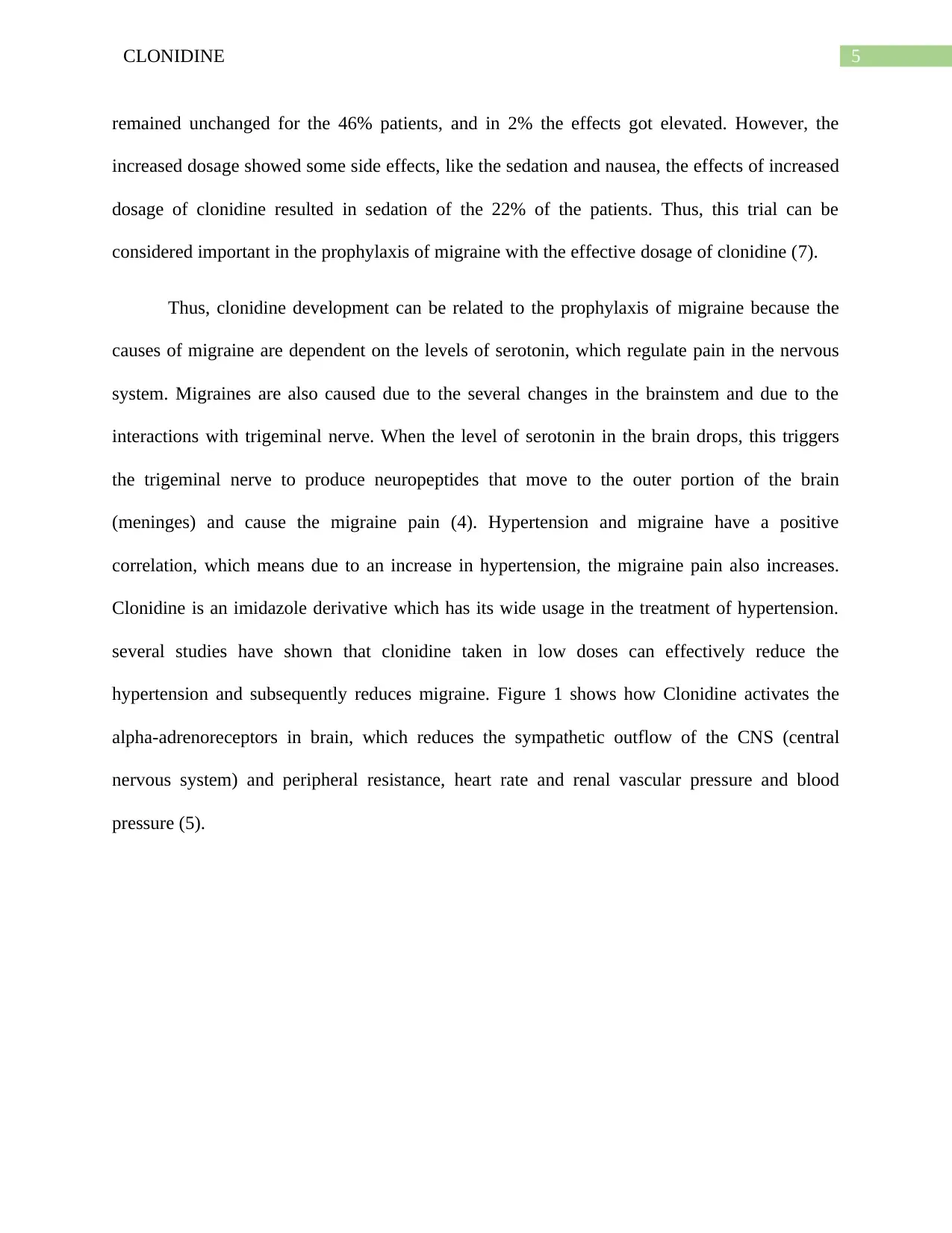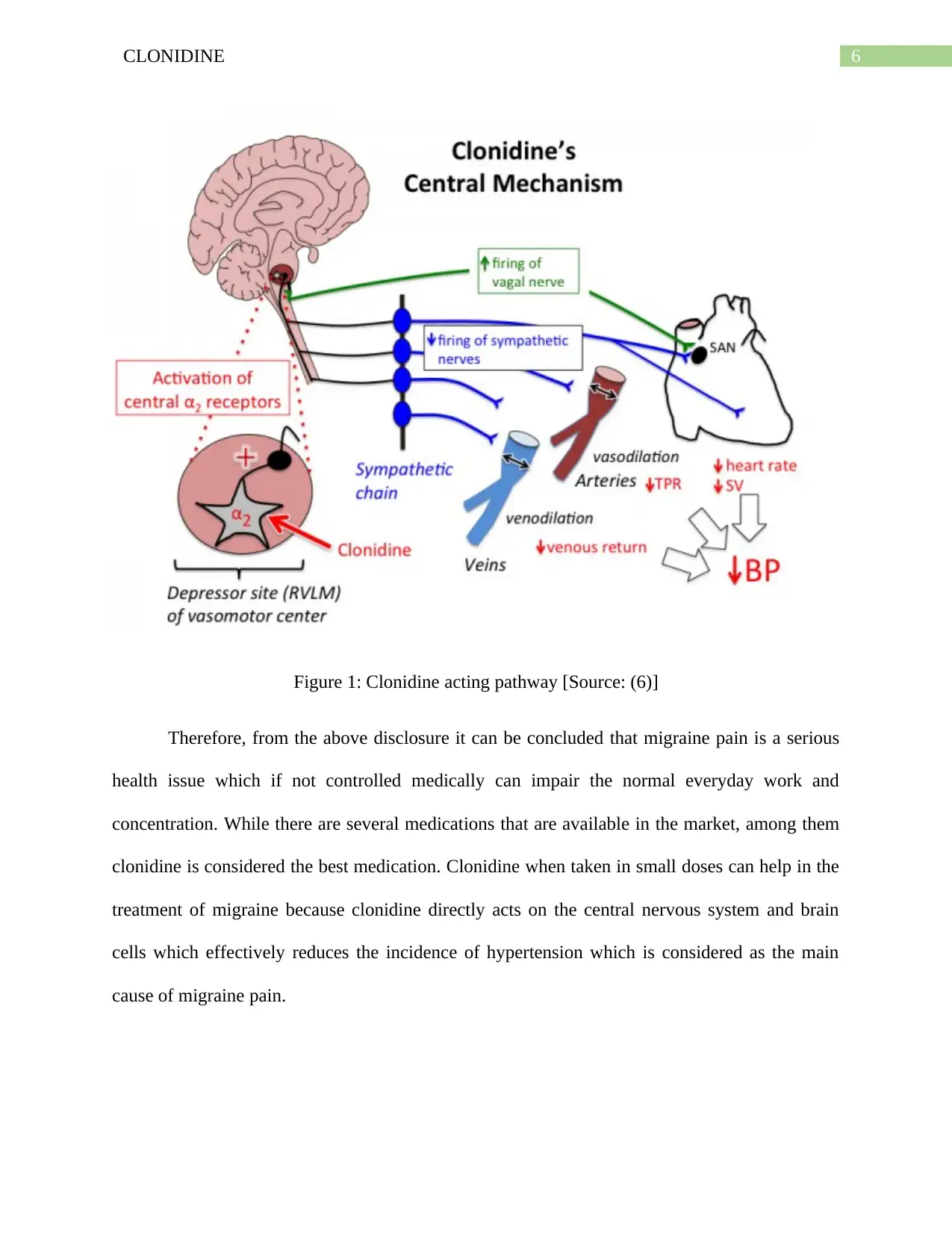An In-Depth Report on Clonidine for the Prophylaxis of Migraine
VerifiedAdded on 2023/06/15
|8
|1742
|443
Report
AI Summary
This report explores the use of clonidine in the prophylaxis of migraine headaches. It begins by defining migraine and its associated symptoms, differentiating it from tension headaches. The report then delves into the history of clonidine, initially developed as a nasal decongestant but later found to have antihypertensive properties. Clonidine's mechanism of action, involving the stimulation of alpha 2A adrenergic receptors in the brainstem, is explained, along with its various therapeutic uses, including hypertension, ADHD, and withdrawal symptoms management. A clinical trial is discussed, highlighting the effectiveness of clonidine in reducing the frequency and duration of migraine attacks, while also noting potential side effects like sedation and nausea. The report concludes that clonidine, particularly in low doses, can be beneficial in migraine prophylaxis due to its impact on the central nervous system and its ability to reduce hypertension, a known trigger for migraines. The report references several studies and sources to support its findings.

Running head: CLONIDINE
Clonidine in Prophylaxis of Migraine
Name of the Student:
Name of the University:
Author Note:
Clonidine in Prophylaxis of Migraine
Name of the Student:
Name of the University:
Author Note:
Paraphrase This Document
Need a fresh take? Get an instant paraphrase of this document with our AI Paraphraser

1CLONIDINE
Introduction
Migraine is a term which is commonly used to describe mild to severe headache. Due to
the physiological changes in the brain, a pain starts to develop which causes migraine associated
headaches and other symptoms. Studies show that migraine headaches have a positive relation
with light, sound and smell. Excessive light, certain disturbing sounds and foul and repugnant
smells often increases the intensity of migraine (1). The probable symptoms include vomiting or
nausea. Some patients complain that they experience pain on just one side of the brain while pain
on both sides of the brain are also reported. The migraine associated pain is often reported as a
throbbing or pounding pain. Designating all types and forms of headaches as migraine is not
appropriate because there is another form of headache which is associated with tension and it
occurs due to muscle contraction of the neck, face and scalp (2).
Boehringer Ingelheim Pharma decided to discover a peripherally active adrenergic
compound for nasal decongestion in the form of nose drops and task was given to to chemist
named Helmut Stahle. It was believed that decongestive agents are derived from imidazoline
structure. He ended up discovering Clonidine by introducing chlorine atoms as substituents in the
2- and 6- positions of the phenyl ring. It was found out that clonidine has more antihypertensive
activity than decongestant (5).
Clonidine is indicated in lowering blood pressure, used in the prophylaxis of vascular
migraine headaches, treatment of severe dysmenorrhea, management of vasomotor symptoms
associated with menopause, in conjunction with benzodiazepines for the treatment of alcohol
withdrawal, to manage nicotine dependence, use in the treatment of open-angle and secondary
glaucoma and attention-deficit hyperactivity (ADHD) is also treated (6).
Introduction
Migraine is a term which is commonly used to describe mild to severe headache. Due to
the physiological changes in the brain, a pain starts to develop which causes migraine associated
headaches and other symptoms. Studies show that migraine headaches have a positive relation
with light, sound and smell. Excessive light, certain disturbing sounds and foul and repugnant
smells often increases the intensity of migraine (1). The probable symptoms include vomiting or
nausea. Some patients complain that they experience pain on just one side of the brain while pain
on both sides of the brain are also reported. The migraine associated pain is often reported as a
throbbing or pounding pain. Designating all types and forms of headaches as migraine is not
appropriate because there is another form of headache which is associated with tension and it
occurs due to muscle contraction of the neck, face and scalp (2).
Boehringer Ingelheim Pharma decided to discover a peripherally active adrenergic
compound for nasal decongestion in the form of nose drops and task was given to to chemist
named Helmut Stahle. It was believed that decongestive agents are derived from imidazoline
structure. He ended up discovering Clonidine by introducing chlorine atoms as substituents in the
2- and 6- positions of the phenyl ring. It was found out that clonidine has more antihypertensive
activity than decongestant (5).
Clonidine is indicated in lowering blood pressure, used in the prophylaxis of vascular
migraine headaches, treatment of severe dysmenorrhea, management of vasomotor symptoms
associated with menopause, in conjunction with benzodiazepines for the treatment of alcohol
withdrawal, to manage nicotine dependence, use in the treatment of open-angle and secondary
glaucoma and attention-deficit hyperactivity (ADHD) is also treated (6).

2CLONIDINE
Clonidine acts by stimulation of the centrally active alpha 2A subtype of alpha adrenergic
receptors in the brainstem, causing decrease in sympathetic outflow of central nervous system.
Clonidine is imidazole derivative and metabolized by cytochrome P450 (CYP). Clonidine is
therapeutically active in lowering blood pressure in conjunction with other drugs. Clonidine is
also used in other conditions like neuropathy, smoking and alcohol cessation, attention deficit
syndrome, vascular headache, menopausal symptoms, diabetic diarrhoea, and restless leg
disorder. Clonidine was first approved in US in 1974 and still widely used for various
indications. Mostly clonidine is indicated in hypertension, but sometime also used for cancer
pain management, attention deficit syndrome and menopausal flushing in some parts of the
world. In NHS clonidine is mainly used for hypertension and menopausal flushing. Unlicensed
use of clonidine includes Tourette syndrome, sedation, migraine, and to alleviate symptoms of
alcohol, nicotine and narcotic withdrawal. Clonidine available in tablet (25mcg, 100mcg) and
injection (150mcg). Clonidine dose in adults is 50-100mcg three times daily, and can be
increased steadily 2nd or 3rd day until control achieved. Main side effects are sedation, fatigue,
bradycardia, dry mouth, headache, dizziness, postural hypotension, male impotence and
gastrointestinal tract disturbance. (1)
Clonidine acts by stimulation of the centrally active alpha 2A subtype of alpha adrenergic
receptors in the brainstem, causing decrease in sympathetic outflow of central nervous system.
Clonidine is imidazole derivative and metabolized by cytochrome P450 (CYP). Clonidine is
therapeutically active in lowering blood pressure in conjunction with other drugs. Clonidine is
also used in other conditions like neuropathy, smoking and alcohol cessation, attention deficit
syndrome, vascular headache, menopausal symptoms, diabetic diarrhoea, and restless leg
disorder. Clonidine was first approved in US in 1974 and still widely used for various
indications. Mostly clonidine is indicated in hypertension, but sometime also used for cancer
pain management, attention deficit syndrome and menopausal flushing in some parts of the
world. In NHS clonidine is mainly used for hypertension and menopausal flushing. Unlicensed
use of clonidine includes Tourette syndrome, sedation, migraine, and to alleviate symptoms of
alcohol, nicotine and narcotic withdrawal. Clonidine available in tablet (25mcg, 100mcg) and
injection (150mcg). Clonidine dose in adults is 50-100mcg three times daily, and can be
increased steadily 2nd or 3rd day until control achieved. Main side effects are sedation, fatigue,
bradycardia, dry mouth, headache, dizziness, postural hypotension, male impotence and
gastrointestinal tract disturbance. (1)
⊘ This is a preview!⊘
Do you want full access?
Subscribe today to unlock all pages.

Trusted by 1+ million students worldwide

3CLONIDINE
C9H9Cl2N3.HCl Mol Wt.
266.56
STRUCTURE OF CLONIDINE (Source: Ref 4)
Clonidine tablet has duration of action of 3-5 hours and half-life of 12-16 hours and
can be prolonged to 41 hours in severed impaired renal function. Normally clonidine prescribed
after dinner or bedtime because of its sedating effects. Clonidine primarily activates presynaptic
auto receptors in locus coeruleus and reduces norepinephrine release. Reduction in plasma levels
of norepinephrine links with its antihypertensive effect. In USA clonidine extended release tablet
used as adjunctive therapy in children for attention deficit hyperactivity disorder. Sudden
withdrawal can rebound hypertension due to rebound in sympathetic outflow. That’s why
clonidine therapy needs to be gradually tapered to discontinue in easing rebound side effects. (2)
Sudden withdrawal in patients on high doses of Clonidine may results in agitation, restlessness,
palpitation, tremor, nervousness, abdominal symptoms and headache. Catapres (Clonidine) tablet
contains lactose monohydrate and patient who got galactose intolerance, should avoid this
medicine. Clonidine and its metabolites are extensively excreted in urine, and dosage should be
adjusted according to response and it can show variability in patients with renal insufficiency.
C9H9Cl2N3.HCl Mol Wt.
266.56
STRUCTURE OF CLONIDINE (Source: Ref 4)
Clonidine tablet has duration of action of 3-5 hours and half-life of 12-16 hours and
can be prolonged to 41 hours in severed impaired renal function. Normally clonidine prescribed
after dinner or bedtime because of its sedating effects. Clonidine primarily activates presynaptic
auto receptors in locus coeruleus and reduces norepinephrine release. Reduction in plasma levels
of norepinephrine links with its antihypertensive effect. In USA clonidine extended release tablet
used as adjunctive therapy in children for attention deficit hyperactivity disorder. Sudden
withdrawal can rebound hypertension due to rebound in sympathetic outflow. That’s why
clonidine therapy needs to be gradually tapered to discontinue in easing rebound side effects. (2)
Sudden withdrawal in patients on high doses of Clonidine may results in agitation, restlessness,
palpitation, tremor, nervousness, abdominal symptoms and headache. Catapres (Clonidine) tablet
contains lactose monohydrate and patient who got galactose intolerance, should avoid this
medicine. Clonidine and its metabolites are extensively excreted in urine, and dosage should be
adjusted according to response and it can show variability in patients with renal insufficiency.
Paraphrase This Document
Need a fresh take? Get an instant paraphrase of this document with our AI Paraphraser

4CLONIDINE
About 70% of Clonidine excreted in urine as unchanged parent drug and 20% excreted with
faeces of administered drug. In patients using contact lenses, clonidine can cause decreased
lacrimation. Clonidine is available Catapres tablet and injection as brand by Boehringer
Ingelheim, and various generics also available in the market. (3)
Clonidine was first seen in to use in the year 1966. Firstly, the drug was developed in the
treatment of hypersensitivity and was traded under the name of Catapres. Initially clonidine was
widely used in the treatment of nicotine, opium and alcohol withdrawal syndromes. Tourette’s
syndrome and attention-deficit/hyperactivity disorder (ADHD). Later, U.S Food and drug
administration allowed clonidine to be used in the treatment of high blood pressure. Clonidine
was also found to act specifically to act on nerve cells of the brain that helped in lowering the
blood pressure (3).
A clinical was conducted in which consolidated the development of clonidine in the
prophylaxis of migraine. In the trial clonidine was given in the dose of 25 micro grams thrice per
day which reduced the mean number of migraine attacks from 3.94 to 2.26 a month. However,
after increasing the dosage to 50 micro grams, the mean number of migraine attack reduced from
4 to 1.88 during the treatment process. In the 25 micro gram dosage, 44% of the patients shows
reduced attacks, while it was unchanged in the 46% of the patients and the remaining 10%
showed increased attacks. In the 50 micro gram dosage group, 58% of the patients reported
reduced attacks and in the 40% of the patients, there was no change. While in the remaining 1%,
there was increased incidence of attacks. Also the duration of the attacks was considered for the
2 types of doses. In the 25 microgram dosage, the duration of pain reduced in the 38% of the
patients, while unchanged in the 60% and elevated in the remaining 2%. The same way in the 50
microgram clonidine dosage, the duration of pain reduced in the 52% of the patients, while it
About 70% of Clonidine excreted in urine as unchanged parent drug and 20% excreted with
faeces of administered drug. In patients using contact lenses, clonidine can cause decreased
lacrimation. Clonidine is available Catapres tablet and injection as brand by Boehringer
Ingelheim, and various generics also available in the market. (3)
Clonidine was first seen in to use in the year 1966. Firstly, the drug was developed in the
treatment of hypersensitivity and was traded under the name of Catapres. Initially clonidine was
widely used in the treatment of nicotine, opium and alcohol withdrawal syndromes. Tourette’s
syndrome and attention-deficit/hyperactivity disorder (ADHD). Later, U.S Food and drug
administration allowed clonidine to be used in the treatment of high blood pressure. Clonidine
was also found to act specifically to act on nerve cells of the brain that helped in lowering the
blood pressure (3).
A clinical was conducted in which consolidated the development of clonidine in the
prophylaxis of migraine. In the trial clonidine was given in the dose of 25 micro grams thrice per
day which reduced the mean number of migraine attacks from 3.94 to 2.26 a month. However,
after increasing the dosage to 50 micro grams, the mean number of migraine attack reduced from
4 to 1.88 during the treatment process. In the 25 micro gram dosage, 44% of the patients shows
reduced attacks, while it was unchanged in the 46% of the patients and the remaining 10%
showed increased attacks. In the 50 micro gram dosage group, 58% of the patients reported
reduced attacks and in the 40% of the patients, there was no change. While in the remaining 1%,
there was increased incidence of attacks. Also the duration of the attacks was considered for the
2 types of doses. In the 25 microgram dosage, the duration of pain reduced in the 38% of the
patients, while unchanged in the 60% and elevated in the remaining 2%. The same way in the 50
microgram clonidine dosage, the duration of pain reduced in the 52% of the patients, while it

5CLONIDINE
remained unchanged for the 46% patients, and in 2% the effects got elevated. However, the
increased dosage showed some side effects, like the sedation and nausea, the effects of increased
dosage of clonidine resulted in sedation of the 22% of the patients. Thus, this trial can be
considered important in the prophylaxis of migraine with the effective dosage of clonidine (7).
Thus, clonidine development can be related to the prophylaxis of migraine because the
causes of migraine are dependent on the levels of serotonin, which regulate pain in the nervous
system. Migraines are also caused due to the several changes in the brainstem and due to the
interactions with trigeminal nerve. When the level of serotonin in the brain drops, this triggers
the trigeminal nerve to produce neuropeptides that move to the outer portion of the brain
(meninges) and cause the migraine pain (4). Hypertension and migraine have a positive
correlation, which means due to an increase in hypertension, the migraine pain also increases.
Clonidine is an imidazole derivative which has its wide usage in the treatment of hypertension.
several studies have shown that clonidine taken in low doses can effectively reduce the
hypertension and subsequently reduces migraine. Figure 1 shows how Clonidine activates the
alpha-adrenoreceptors in brain, which reduces the sympathetic outflow of the CNS (central
nervous system) and peripheral resistance, heart rate and renal vascular pressure and blood
pressure (5).
remained unchanged for the 46% patients, and in 2% the effects got elevated. However, the
increased dosage showed some side effects, like the sedation and nausea, the effects of increased
dosage of clonidine resulted in sedation of the 22% of the patients. Thus, this trial can be
considered important in the prophylaxis of migraine with the effective dosage of clonidine (7).
Thus, clonidine development can be related to the prophylaxis of migraine because the
causes of migraine are dependent on the levels of serotonin, which regulate pain in the nervous
system. Migraines are also caused due to the several changes in the brainstem and due to the
interactions with trigeminal nerve. When the level of serotonin in the brain drops, this triggers
the trigeminal nerve to produce neuropeptides that move to the outer portion of the brain
(meninges) and cause the migraine pain (4). Hypertension and migraine have a positive
correlation, which means due to an increase in hypertension, the migraine pain also increases.
Clonidine is an imidazole derivative which has its wide usage in the treatment of hypertension.
several studies have shown that clonidine taken in low doses can effectively reduce the
hypertension and subsequently reduces migraine. Figure 1 shows how Clonidine activates the
alpha-adrenoreceptors in brain, which reduces the sympathetic outflow of the CNS (central
nervous system) and peripheral resistance, heart rate and renal vascular pressure and blood
pressure (5).
⊘ This is a preview!⊘
Do you want full access?
Subscribe today to unlock all pages.

Trusted by 1+ million students worldwide

6CLONIDINE
Figure 1: Clonidine acting pathway [Source: (6)]
Therefore, from the above disclosure it can be concluded that migraine pain is a serious
health issue which if not controlled medically can impair the normal everyday work and
concentration. While there are several medications that are available in the market, among them
clonidine is considered the best medication. Clonidine when taken in small doses can help in the
treatment of migraine because clonidine directly acts on the central nervous system and brain
cells which effectively reduces the incidence of hypertension which is considered as the main
cause of migraine pain.
Figure 1: Clonidine acting pathway [Source: (6)]
Therefore, from the above disclosure it can be concluded that migraine pain is a serious
health issue which if not controlled medically can impair the normal everyday work and
concentration. While there are several medications that are available in the market, among them
clonidine is considered the best medication. Clonidine when taken in small doses can help in the
treatment of migraine because clonidine directly acts on the central nervous system and brain
cells which effectively reduces the incidence of hypertension which is considered as the main
cause of migraine pain.
Paraphrase This Document
Need a fresh take? Get an instant paraphrase of this document with our AI Paraphraser

7CLONIDINE
Reference
1. Nihgov. Nihgov. [Online]. Available from: .https://livertox.nih.gov/Clonidine.htm
[Accessed 7 December 2017].
2. Sciencedirectcom.Sciencedirectcom.[Online].Availablefrom:
https://www.sciencedirect.com/science/article/pii/B9780080552323614953 [Accessed 7
December 2017)
3. Medicinesorguk. Medicinesorguk. [Online]. Available from:
3.https://beta.medicines.org.uk/emc/product/2200 [Accessed 7 December 2017].
4. Drugscom. Drugscom. [Online]. Available from:
https://www.drugs.com/pro/clonidine.html [Accessed 7 December 2017].
5. StaÈhle, H. A historical perspective: development of clonidine. BaillieÁ re's Best
Practice and research. 2000;14(2): 237±246.
6. Drugbankca. Drugbankca. [Online]. Available from:
https://www.drugbank.ca/indications/DBCOND0029450 [Accessed 7 December 2017].
7. Goadsby PJ, Sprenger T. Current practice and future directions in the prevention
and acute management of migraine. The Lancet Neurology. 2010 Mar
31;9(3):285-98.
Reference
1. Nihgov. Nihgov. [Online]. Available from: .https://livertox.nih.gov/Clonidine.htm
[Accessed 7 December 2017].
2. Sciencedirectcom.Sciencedirectcom.[Online].Availablefrom:
https://www.sciencedirect.com/science/article/pii/B9780080552323614953 [Accessed 7
December 2017)
3. Medicinesorguk. Medicinesorguk. [Online]. Available from:
3.https://beta.medicines.org.uk/emc/product/2200 [Accessed 7 December 2017].
4. Drugscom. Drugscom. [Online]. Available from:
https://www.drugs.com/pro/clonidine.html [Accessed 7 December 2017].
5. StaÈhle, H. A historical perspective: development of clonidine. BaillieÁ re's Best
Practice and research. 2000;14(2): 237±246.
6. Drugbankca. Drugbankca. [Online]. Available from:
https://www.drugbank.ca/indications/DBCOND0029450 [Accessed 7 December 2017].
7. Goadsby PJ, Sprenger T. Current practice and future directions in the prevention
and acute management of migraine. The Lancet Neurology. 2010 Mar
31;9(3):285-98.
1 out of 8
Your All-in-One AI-Powered Toolkit for Academic Success.
+13062052269
info@desklib.com
Available 24*7 on WhatsApp / Email
![[object Object]](/_next/static/media/star-bottom.7253800d.svg)
Unlock your academic potential
Copyright © 2020–2025 A2Z Services. All Rights Reserved. Developed and managed by ZUCOL.